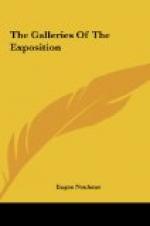Gallery 45.
Charles Morris Young’s art is so refreshing, so spontaneous in every way, that it catches one’s eye immediately on passing on into this room. His work deserves recognition for more than one reason. His handling of paint is fresh and clear and a direct aiming for a final expression of what he wants to convey. Any one of the six subjects is well handled. They give one the feeling of the artist’s thorough understanding of his material. His own “House in Winter” and the “Red Mill” reach the high-water mark of landscape painting in the exhibition. Griffin’s pictures, on another wall, so openly disregard technical rules in their careless superimposition of unnecessary paint that in spite of a great richness of colour and a certain suggestion of truth, they are not apt to hold one one’s affection very long. They are sincere, I admit, but careless in technique. There is no doubt about it, because heavy paint and bare pieces of canvas will not make durable pictures. Birge Harrison is disappointing in two pastels which seem too chromo-like, too mechanical, to carry their point.
Gallery 44.
This collection is not at all without interest, but with few exceptions the pictures in it are not strong enough to hold their own with so many good things abounding elsewhere. Ralph Clarkson’s portrait, Bartlett’s schoolyard, Perrine’s technically unique landscape, are all meritorious.
Gallery 43.
Frederic M. DuMond’s “Sea Carvings” in the corner, and Nahl’s decorative composition attract, each in its way, while in another corner a badly skyed portrait by Hinkle is scarcely given a chance.
Gallery 74.
It will be necessary to make a little journey over to the inner side of the arch of the building to continue and finish the art of modern America. In this small Gallery, adjoining Sargent’s, nothing stirring happens. Landscapes predominate, with varying interest, but nothing with any style or unity of expression presents itself, with the exception of Carl Oscar Borg’s “Campagna Romana” and a fine sky over the door by William J. Kaula. The landscapes of G. W. Sotter and Will S. Robinson stand out among the rest.
Gallery 73.
Next door, in 73, Alson Skinner Clark has been given the privilege of almost an entire Gallery, without any other justification than historical interest in his shallow Panama scenes, devoid of any quality. They are illustrations — that is all. Gifford Beal disappoints in some superficial paintings of commonplace subjects, which a skillful technique might easily have turned into something worth while. His “Old Town Terrace” is much the best, but the collection makes one apprehensive for Beal’s future performances. Paul King’s canvas over the door is excellent, well painted, and interesting in subject.




